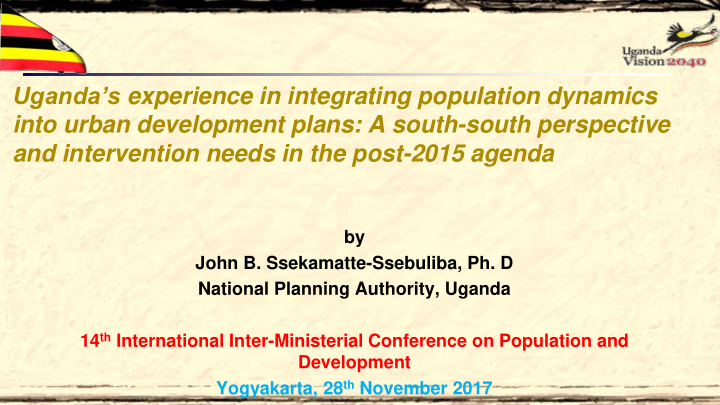



Uganda’s experience in integrating population dynamics into urban development plans: A south-south perspective and intervention needs in the post-2015 agenda by John B. Ssekamatte-Ssebuliba, Ph. D National Planning Authority, Uganda 14 th International Inter-Ministerial Conference on Population and Development Yogyakarta, 28 th November 2017
Presentation Outline Uganda’s development context Tackling urbanization issues New strategic focus
Development context: Uganda’s Vision 2040 “A transformed Ugandan society from a peasant to a modern and prosperous country within 30 years” with a per capita GDP of $9,500; Recognizes Uganda’s rapid population growth, young age structure and consequent high child dependency burden among the threats to the achievement of socioeconomic development
Vision Actualization 3 ten-year perspective plans 6 five-year development plans (NDPs) Started with 1 st of 6 NDPs in 2010 Now in middle on 2 nd NDP
DEVELOPMENT STRATEGIES • Urbanization • Private Sector – led growth • Industrialization -Value Addition (agro processing and mineral beneficiation) and light manufacturing • Fast Tracking Skills Development • A Quasi-Market Approach • Strengthening governance mechanisms Urbanism as a transformation driver 5
BUT, FINDING: URBANISM HAD FAILED Problem of primacy: the capital Over all Secondary Net Enrollment Kampala with > 40% of urban population Preponderance of urban sprawl, curtailing urbanism development Urban centres were growing more from natural increase (TFR 4), leading to urban poor and creation of slums
More indicators of failed urbanism Labour force was not appropriately skilled Labour force was not sufficiently educated Health indicators were unsatisfactory
New strategic focus It was observed that population factors had not been sufficiently incorporated into urban planning; Decision: Revise population policy to center on PLANNED URBANIZATION (focusing on population factors in the context of SDG 11); formerly focused on rural transformation
Designed a four-pronged strategy to achieve the original target of cities as change agents: 1. Aggressive mindset change campaign to change: Attitudes towards family size Settlement habits Rural-like life styles (e.g. energy use)
2. Promote apartment-type housing (high-rise) Rationalizing land use Family size reduction Change in service delivery model: people-centered
3. Create enabling environment for private sector investment in agricultural value chains Design private sector- friendly policies and programmes – tax system, credit, terms of trade Public investment in infrastructure and other growth boosters
4. Invest in the large segment of young people created from successive years of high fertility Develop a conscious investment strategy to convert the abundant human resource into human capital: Human Capital Development Proper health starting from early childhood development (ECD) All inclusive competence-based education Appropriate skilling programme driven by the existing and emerging job markets
Overall Population Policy Goal To harness the demographic dividend to create an economic boost in the country in the medium to long term
THANK YOU FOR YOUR KIND ATTENTION 14
Recommend
More recommend